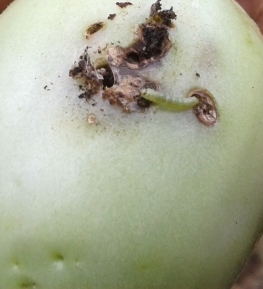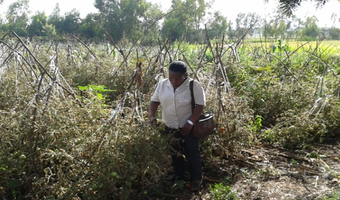A tomato disease that wipes upto 100 percent yields in days has hit the country putting over Sh14billion annually that the crop brings to the economy at risk.
Dubbed Tuta Absoluta the dangerous pest which said to have originated from Europe and South America was discovered in the country a few months ago. Reports indicate that it was first reported in Isiolo in 2014 but now has spread to most parts of Kenya with cases being recorded in Nairobi,Meru, Kirinyaga, Njoro, Kakamega, Lamu and Loitoktok.
According to Dr Mbaka Jessica the National Coordinator of the USAID funded Integrated Pest Management Collaborative Research Support Project, the disease first got her attention when she attended an international workshop on ‘Invasive species identification and management in the tropics’ which was held in early May 2014 in Senegal. “At the conference among the topics covered was the tomato leaf miner, Tuta absoluta, a new pest of tomato spreading in many parts of the world,” explained Dr. Mbaka.
However by then, Tuta absoluta had not been reported in Kenya but the scientist was to face the tales of the destructive pest earlier than she had thought. The following week after her return from the workshop, farmers from Mea, Kirinyaga County called Dr Mbaka and described damage symptoms that she thought resembled those of Tuta absoluta. “I quickly organised a visit to Mwea for confirmation where the pest was confirmed on tomato growing in the open field and in greenhouses.”
 Farmers from the area were then trained on the identification and the mitigation of the pest at KARI- Mwea by Dr Jesca Mbaka under the IPM-CRSP project. This was successful as it enlightened more farmers of the presence of the pest on their tomato farm. “Large areas of mined leaves makes farmers mistake it for late blight but after the training the farmers revealed that it was a serious problem that needed a quick solution.”
Farmers from the area were then trained on the identification and the mitigation of the pest at KARI- Mwea by Dr Jesca Mbaka under the IPM-CRSP project. This was successful as it enlightened more farmers of the presence of the pest on their tomato farm. “Large areas of mined leaves makes farmers mistake it for late blight but after the training the farmers revealed that it was a serious problem that needed a quick solution.”
The larvae can also mine new fruits leaving holes and frass on the surface. Other pathogens enter the wholes and make the fruits rot. The larva feeds voraciously upon tomato plants, producing large galleries in leaves, burrowing in stalks, and consuming apical buds and green and ripe fruits. It is capable of causing a yield loss of 100 percent. The pest adult is a moth, meaning that it is active at night. It will thus lay eggs mainly at night. The moth is almost same size and posture as diamondback moth when looked at a distance. The larva (caterpillar) is the damaging stage.
The emergence of this pest is a setback to tomato farmers in Kenya and East Africa region as a whole. Dr. Mbaka concurs that by now the pest is well established and millions of Shillings have been lost. “This is likely to get worse as most farmers are still not aware of the problem and coupled with the chilling reports from worried farmers who reported that the pest is tolerant to all the pesticides they are using,” added Dr. Mbaka.
The pest also thrives on other host plants apart from tomatoes which include night shade, egg plant, potato, Datura among others. Currently, there are a combined measures of combating the pest that have suggested by the scientist which include use of light and Pheromone traps for the adult males, Crop rotation- rotate with non- solanaceous crops like night shade.
Farmers are also advised to plant seedlings free from any stages of Tuta and remove all alternative hosts especially those of Solanaceous–Family (Brinjals, Potatoes etc). Other precautionary measures include, Proper field hygiene, burn old plant debris, deep burying of infested fruits and use of screen houses.
The scientist also suggested biological control methods to curb the pest which include Bt based products-Bacillus thuringiensis e.g. Thuricide HP, Dipel 2X WP, Xentari, Florbac 70 DG. Use of Neem based products-Azadirachtin e.g. Nimbecidine EC, Achook0.15%EC. Farmers can also use Naturalyte class-derived from soil fungus-Actinomycetes (Saccharopolysporaspinosa):Tracer 480 SC(Spinosad, Insect growth regulator like Lufenuron, planting of resistant tomato varieties and use of natural enemies- predatory mites, parasitic wasps among others.
 The pest can also be sprayed a chemical pesticides which include Dynamec 1.8 EC (Abamectin), Avaunt150 SL(Indoxacarb). The scientist also advised on the use mixtures and rotation of pesticides with different modes of action in order to reduce the pests’ resistance ability.
The pest can also be sprayed a chemical pesticides which include Dynamec 1.8 EC (Abamectin), Avaunt150 SL(Indoxacarb). The scientist also advised on the use mixtures and rotation of pesticides with different modes of action in order to reduce the pests’ resistance ability.
The use of natural enemies, such as entomopathogenic nematodes, for biological control is still largely under development and not ready to combat this pest effectively and in a cost effective way. The chemical spray is has also been reported as not very effective mainly due to the insects ability to develop resistance. Therefore experts advise that currently the most effective methods of control is the use of pheromones: sex pheromone traps are useful as an early detection tool, then mass trapping and “lure and kill” application of pheromones has been found to be effective to control the pest population. One of the lead suppliers of these sex traps is Kenya Biologics Ltd.
For more expert advice contact;
Dr. Jessica Mbaka 0722882422 KARI THIKA